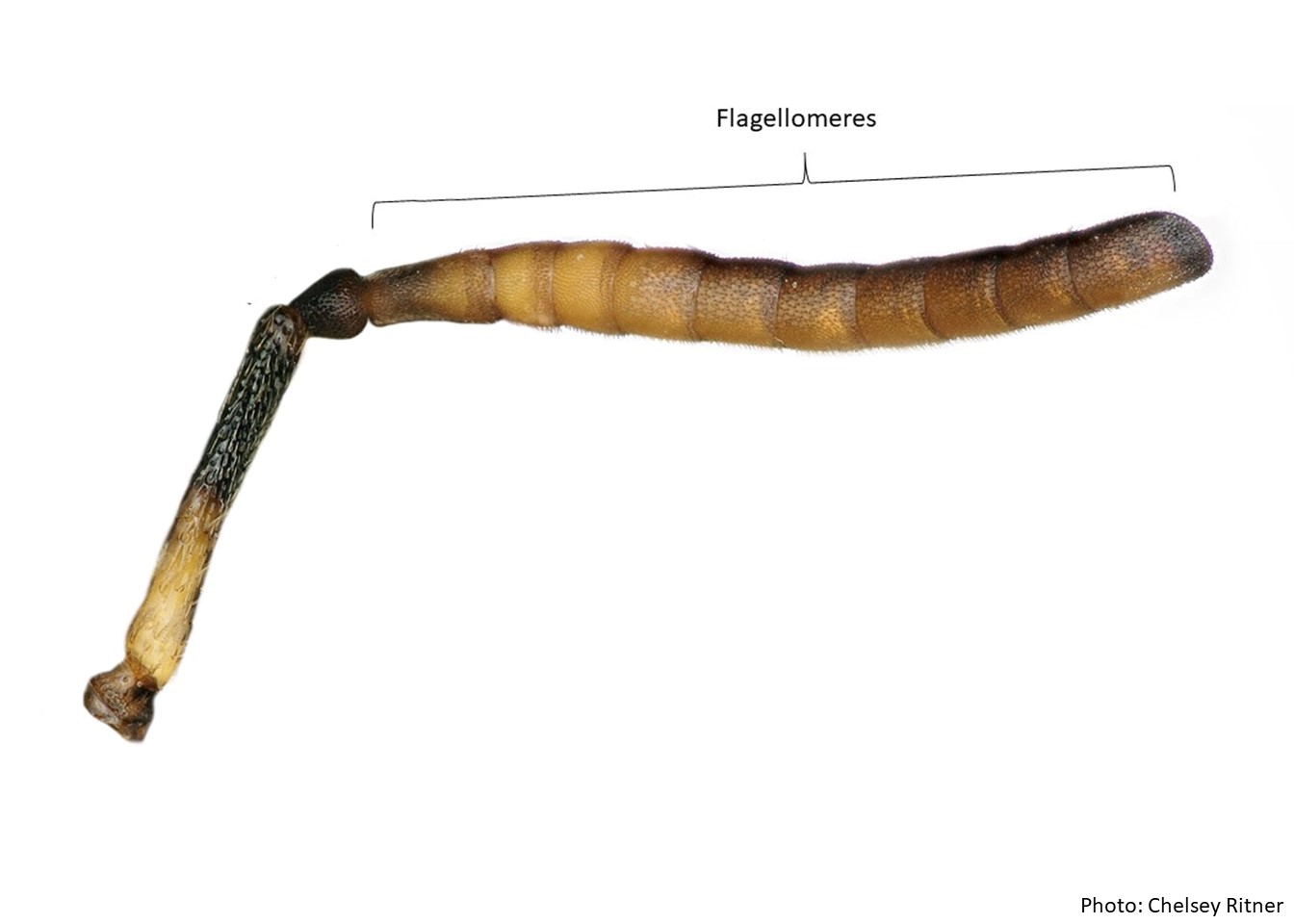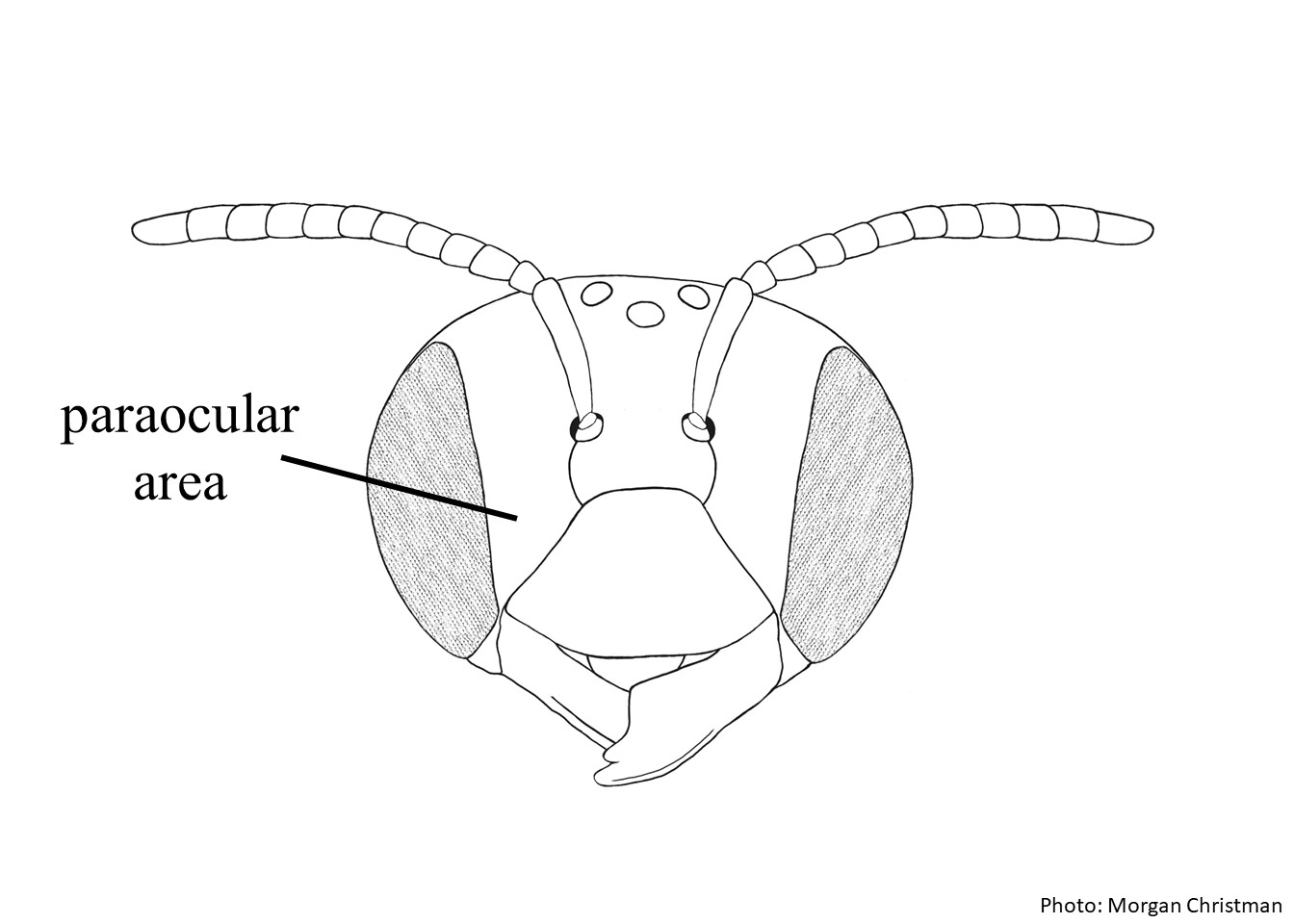Family: Megachilidae
Subfamily: Megachilinae
Tribe: Anthidiini
Genus: Anthidium Fabricius, 1804
Subgenus: A. (Anthidium) Fabricius, 1804
Species: Anthidium jocosum Cresson, 1878
Common name: none
Anthidium (Anthidium) jocosum are primarily black with yellow or ivory maculations and reddish-brown coloration on the antennal flagellumflagellum:
any segment of the antenna past the scape and pedicel , clypeal margin, tegulategula:
, clypeal margin, tegulategula:
the usually oval, small shield-like structure carried at the extreme base of the wing where it attaches to the body, tibiaetibiae:
the segment of the leg, between the femur and the tarsus, tarsitarsi:
the group of segments at the end of the leg following the tibia
, abdomen, and apexapex:
end of any structure
of the mandiblemandible:
bee teeth, so to speak, usually crossed and folded in front of the mouth and femorafemora:
the third segment of the leg, situated between the trochanter and the tibia
(Gonzalez and Griswold 2013Gonzalez and Griswold 2013:
Gonzalez, V.H. and T.L. Griswold. 2013. Wool carder bees of the genus Anthidium in the Western Hemisphere (Hymenoptera: Megachilidae): diversity, host plant associations, phylogeny, and biogeography. Zoological Journal 168: 221ndash;425.). Females have white pubescencepubescence:
short, fine hair
except for yellow to ferruginousferruginous:
rust-colored
hairs on the vertexvertex:
the area between the ocelli and the back of the head, scutumscutum:
the large segment on top of the thorax located between the wings and behind the head
, axillaaxilla:
the triangular or rounded point on the thorax where thoracic muscles meet the forewing of an insect, scutellumscutellum:
shield shaped plate behind scutum, tarsitarsi:
the group of segments at the end of the leg following the tibia
, and sometimes S6S6:
the plates on the underside of the abdomen, often abbreviated when referring to a specific segment to S1, S2, S3, S4, S5, S6, S7, or S8
 . Females and males have a body length of 6.2–8.8 mm and 8.5–8.8 mm, respectively (Gonzalez and Griswold 2013Gonzalez and Griswold 2013:
. Females and males have a body length of 6.2–8.8 mm and 8.5–8.8 mm, respectively (Gonzalez and Griswold 2013Gonzalez and Griswold 2013:
Gonzalez, V.H. and T.L. Griswold. 2013. Wool carder bees of the genus Anthidium in the Western Hemisphere (Hymenoptera: Megachilidae): diversity, host plant associations, phylogeny, and biogeography. Zoological Journal 168: 221ndash;425.).
(modified from Gonzalez and Griswold 2013Gonzalez and Griswold 2013:
Gonzalez, V.H. and T.L. Griswold. 2013. Wool carder bees of the genus Anthidium in the Western Hemisphere (Hymenoptera: Megachilidae): diversity, host plant associations, phylogeny, and biogeography. Zoological Journal 168: 221ndash;425.)
 lacks basalbasal:
lacks basalbasal: depressed apicalapical:
depressed apicalapical: laterallateral:
laterallateral: has preapicalpreapical:
has preapicalpreapical: with median apicalapical:
with median apicalapical: apicalapical:
apicalapical: with blunt laterallateral:
with blunt laterallateral: median lobe is broadly rounded, and broader than long.
median lobe is broadly rounded, and broader than long. is pointed apicallyapically:
is pointed apicallyapically: apicalapical:
apicalapical: laterallateral:
laterallateral: median spine.
median spine. laterallateral:
laterallateral:Anthidium jocosum may be confused with A. utahense based on the small body size, female basitarsibasitarsi:
the segment of the tarsus that is the nearest to the body of the bee, usually the largest of all the tarsal segments lacking dense tomentumtomentum:
a form of pubescence composed of short matted, woolly hair
, female T6T6:
the segments on the top side of the abdomen, often abbreviated when referring to a specific segment to T1, T2, T3, T4, T5, T6, or T7 shape, and male T7T7:
shape, and male T7T7:
the segments on the top side of the abdomen, often abbreviated when referring to a specific segment to T1, T2, T3, T4, T5, T6, or T7 , genitaliagenitalia:
, genitaliagenitalia:
all the genital structures collectively
, and sternasterna:
the plates on the underside of the abdomen, often abbreviated when referring to a specific segment to S1, S2, S3, S4, S5, S6, S7, or S8
 shape (Gonzalez and Griswold 2013Gonzalez and Griswold 2013:
shape (Gonzalez and Griswold 2013Gonzalez and Griswold 2013:
Gonzalez, V.H. and T.L. Griswold. 2013. Wool carder bees of the genus Anthidium in the Western Hemisphere (Hymenoptera: Megachilidae): diversity, host plant associations, phylogeny, and biogeography. Zoological Journal 168: 221ndash;425.). Female A. jocosum can be differentiated from A. utahense by the more broadly rounded T6T6:
the segments on the top side of the abdomen, often abbreviated when referring to a specific segment to T1, T2, T3, T4, T5, T6, or T7 distaldistal:
distaldistal:
place on a segment that is furthest from the place of attachment with the body
margin with a less depressed apicalapical:
near or at the apex or end of any structure
rim, and clypeusclypeus:
a section of the face below the antennae, demarcated by the epistomal sutures and paraocular areaparaocular area:
the area extending along the sides of the face parallel to the eye
 without yellow maculations (Gonzalez and Griswold 2013Gonzalez and Griswold 2013:
without yellow maculations (Gonzalez and Griswold 2013Gonzalez and Griswold 2013:
Gonzalez, V.H. and T.L. Griswold. 2013. Wool carder bees of the genus Anthidium in the Western Hemisphere (Hymenoptera: Megachilidae): diversity, host plant associations, phylogeny, and biogeography. Zoological Journal 168: 221ndash;425.). Male A. jocosum can also be differentiated from A. utahense by the sparser median apicalapical:
near or at the apex or end of any structure
brush on S4S4:
the plates on the underside of the abdomen, often abbreviated when referring to a specific segment to S1, S2, S3, S4, S5, S6, S7, or S8
 , less acute laterallateral:
, less acute laterallateral:
relating, pertaining, or attached to the side
lobe on S6S6:
the plates on the underside of the abdomen, often abbreviated when referring to a specific segment to S1, S2, S3, S4, S5, S6, S7, or S8
 , and darker, more sclerotizedsclerotized:
, and darker, more sclerotizedsclerotized:
hardened by the formation of sclerotin, specifically the exoskeleton of an insect
median lobe on S6S6:
the plates on the underside of the abdomen, often abbreviated when referring to a specific segment to S1, S2, S3, S4, S5, S6, S7, or S8
 (Gonzalez and Griswold 2013Gonzalez and Griswold 2013:
(Gonzalez and Griswold 2013Gonzalez and Griswold 2013:
Gonzalez, V.H. and T.L. Griswold. 2013. Wool carder bees of the genus Anthidium in the Western Hemisphere (Hymenoptera: Megachilidae): diversity, host plant associations, phylogeny, and biogeography. Zoological Journal 168: 221ndash;425.).
Anthidium jocosum adults have been recorded in flight from late March to early July, with peak activity occurring from April to the first half of June (Gonzalez and Griswold 2013Gonzalez and Griswold 2013:
Gonzalez, V.H. and T.L. Griswold. 2013. Wool carder bees of the genus Anthidium in the Western Hemisphere (Hymenoptera: Megachilidae): diversity, host plant associations, phylogeny, and biogeography. Zoological Journal 168: 221ndash;425.).
Anthidium jocosum is a generalist that has been observed visiting a variety of species within Asteraceae, Boraginaceae, Cactaceae, Fabaceae, Lamiaceae, Loasaceae, Malvaceae, Onagraceae, Polemoniaceae, Polygonaceae, Plantaginaceae, Rhamnaceae, and Zygophyllaceae (Gonzalez and Griswold 2013Gonzalez and Griswold 2013:
Gonzalez, V.H. and T.L. Griswold. 2013. Wool carder bees of the genus Anthidium in the Western Hemisphere (Hymenoptera: Megachilidae): diversity, host plant associations, phylogeny, and biogeography. Zoological Journal 168: 221ndash;425.).
Nesting behavior is unknown.
Anthidium jocosum occur in California, southern Nevada, Arizona, and southwestern New Mexico. One male was also found in Colorado. In Mexico, they are found primarily in Baja California and Sonora. They are found primarily in the Great Basin shrub steppe; Mojave, Sonoran, and Chihuahuan Desert; California coastal sage and chaparral; and Sierra Madre occidental pine-oak forests (Gonzalez and Griswold 2013Gonzalez and Griswold 2013:
Gonzalez, V.H. and T.L. Griswold. 2013. Wool carder bees of the genus Anthidium in the Western Hemisphere (Hymenoptera: Megachilidae): diversity, host plant associations, phylogeny, and biogeography. Zoological Journal 168: 221ndash;425.).
Distribution map generated by Discover Life -- click on map for details, credits, and terms of use.
Gonzalez, V.H. and T.L. Griswold. 2013. Wool carder bees of the genus Anthidium in the Western Hemisphere (Hymenoptera: Megachilidae): diversity, host plant associations, phylogeny, and biogeography. Zoological Journal of the Linnean Society 168: 221-425.